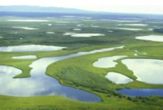Pleistocene Park Could Solve Mystery of Mammoth's Extinction

Sergey Zimov's Pleistocene Park is unlike any preserve on the planet.
In northern Siberia, Zimov and his colleagues are attempting to restore a large area of wetlands and forest to the dry landscape that existed more than 10,000 years ago. They are re-introducing herbivores and predators they think will alter the biology and ecology of the region to its previous state.
The effort is designed to solve a longstanding mystery of what happened to the woolly mammoths, and it might also help reduce global warming, Zimov says.
The park's primary purpose is to reveal what role various animals had on the ancient ecosystem and whether humans are to blame for the mammoth's extinction. The giant mammals, related to elephants, once roamed many parts of the planet, including North America. Their last holdout was on an island off the coast of Alaska about 8,000 years ago.
((ImgTag||right|null|null|null|false)) Sergey Zimov ? Science
Zimov, director of the Northeast Science Station in Cherskii in the Republic of Sakha, has led the park-creation effort over the past decade. He describes the ambitious project today in the journal Science.
Dramatic change
The Pleistocene era ran from about 1.8 million years ago to 10,000 years ago, when the last ice age ended. Like about half the land area of the planet at the time, northeastern Siberia was covered in arid grasslands.
Sign up for the Live Science daily newsletter now
Get the world’s most fascinating discoveries delivered straight to your inbox.
"There, vast dust-covered plains and valleys dominated the landscape," Zimov writes. "Mammoths, woolly rhinoceroses, bison, horses, reindeer, musk-oxen, elk, moose, saiga, and yaks grazed on grasslands under the predatory gaze of cave lions and wolves."
About 10,000 years ago, the ecosystem disappeared. Mosses and forests, their growth fueled by increased humidity, replaced the dry tundra that had been the mammoth's home. The planet warmed, and the mammoths disappeared.
Scientists for decades have debated why they died off, however.
The park area as it looks now. ? Science
"It actually might not have been the climatic changes that killed off these great animals and their ecosystem," Zimov argues. "More consequential, perhaps, were shifts in ecological dynamics wrought by people who relied on increasingly efficient hunting practices, which decimated the very populations of grazing animals that maintained the tundra steppe."
A study released last month supports Zimov's view, finding that ancient waves of human expansion corresponded to declines in populations of various elephant species.
Zimov calls the human species an ecosystem terminator, contending that our ancestors permanently altered the planet as time moved into the Holocene era.
"The mammoth ecosystem was the first large-scale victim," he says, "but the global destruction of grasslands only accelerated in the Holocene when people invented agriculture, and began raising cattle."
Bison, tigers, and eventually mammoths?
The park currently covers an area of 40,000 acres (160 square kilometers). So far, Zimov and his colleagues, with government approval, have re-introduced or fostered the survival of reindeer, moose, wild horses, musk-oxen, hares, marmots, and ground squirrels, along with predators such as wolves, bears, lynxes, wolverines and foxes.
Yakutian horses grazing on a snow-covered tundra meadow in northern Siberia. ? Science
"The most important phase of the program will be the reintroduction of bison from Canada and subsequently, when the herbivores are sufficiently abundant, the acclimatization of Siberian tigers," Zimov said.
There is another motive. The region holds a lot of carbon that is sequestered in permafrost. If the planet grows warmer, this permafrost will melt and release the carbon into the atmosphere, where it will add to the heat-trapping blanket of greenhouse gases and fuel further warming. (Already the permafrost in many locations around the globe is disappearing, other studies show.)
Creating a Pleistocene-like grassy, arid ecosystem would prevent the carbon's release, Zimov says.
In a separate effort, scientists with the Mammoth Creation Project hope to find frozen woolly mammoth DNA and inject it into an elephant. If the species could be revived in this longshot program, the mammoths would have a park to play in, scientists figure.
Related Stories
- Prehistoric Humans Wiped Out Elephants
- Scientists Aim to Revive the Woolly Mammoth
- Surviving Extinction: Where Woolly Mammoths Endured
- Ancient Mammoth and Camel Bones Found in Kansas
- Construction Crew Finds Mammoth Bones
Robert is an independent health and science journalist and writer based in Phoenix, Arizona. He is a former editor-in-chief of Live Science with over 20 years of experience as a reporter and editor. He has worked on websites such as Space.com and Tom's Guide, and is a contributor on Medium, covering how we age and how to optimize the mind and body through time. He has a journalism degree from Humboldt State University in California.










